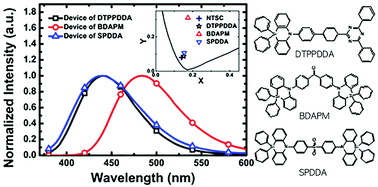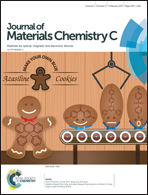Azasiline-based thermally activated delayed fluorescence emitters for blue organic light emitting diodes†
Abstract
Recently, the azasiline unit was introduced as a donor in thermally activated delayed fluorescence (TADF) emitters to realize efficient blue fluorescence from organic light emitting diodes (OLEDs). Utilizing the azasiline unit DTPPDDA in the formation of donor–connector–acceptor (D–C–A) materials resulted in deep blue emission with a Commission Internationale de l'Eclairage (CIE) coordinate of (0.151, 0.087), close to the blue standard of the National Television System Committee (NTSC) of (0.140, 0.080) with 4.7% External Quantum Efficiency (EQE). In the donor–acceptor–donor (D–A–D) type materials of BDAPM and SPDDA, carbonyl and sulfone units were used as the acceptors, respectively. The sulfonyl unit contributed to a large twist of the molecular structure while the carbonyl unit led to a small twist of the molecular structure. As a result, the blue fluorescent OLEDs containing BDAPM and SPDDA demonstrated 11.4% and 2.3% EQEs with CIE Y-values of 0.310 and 0.107, respectively.


 Please wait while we load your content...
Please wait while we load your content...